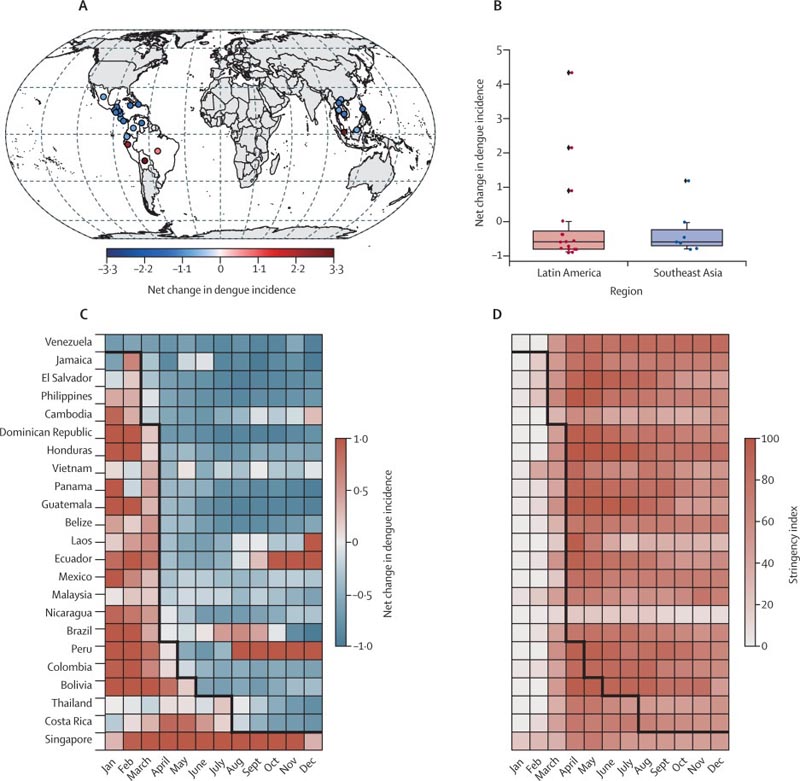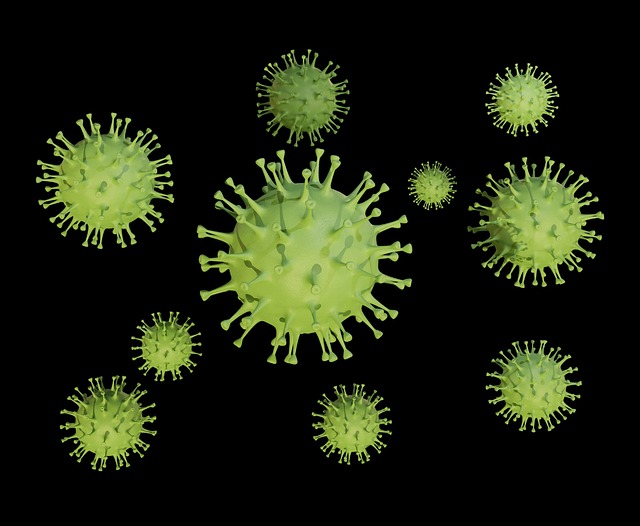Background The COVID-19 pandemic has caused unprecedented disruption to society, indirectly affecting the dynamics of infectious diseases. We aimed to evaluate the effects of COVID-19-related disruption on dengue, a major and expanding acute public health threat, in Southeast Asia and Latin America. Methods We collected data on monthly dengue incidence from WHO weekly reports, climate data from ERA5, and population variables from WorldPop for 23 countries between January 2014 and December 2019 and fit a Bayesian regression model to explain and predict cycles of dengue. Seasonal and multi-annual dengue. We compare model predictions with dengue data reported from January to December 2020, and assess whether deviations from projected incidence since March 2020 are associated with specific public health and social measures (from the Oxford Coronavirus Government database Response Tracer) or human movement behaviors (as measured by Google Mobility Reports). Results We found a steady and prolonged decline in dengue incidence in many dengue-endemic regions starting in March 2020 (2.28 million cases in 2020 vs. 4.08 million cases in 2019; a decrease of 44.1% ). We found a strong association between COVID-19-related disruption (measured independently by social and public health measures and human movement behaviors) and reduced risk of dengue, even after accounting for other drivers of dengue cycles. , including climatic and host immunity (relative risk). 0·01–0·17, p<0·01). Measures related to school closures and reduced time spent in nonresidential areas had the strongest evidence of association with reduced dengue risk, but high collinearity between covariates made specific attribution difficult. Overall, we estimate that 0.72 million (95% CI: 0.12–1.47) fewer dengue cases potentially attributable to COVID-19-related disruption occurred in 2020. Interpretation In most countries, COVID-19-related disruption led to historically low dengue incidence in 2020. Continued monitoring of dengue incidence as COVID-19-related restrictions are eased will be important and could provide new insights into transmission processes and intervention options. |

Dengue incidence and government interventions in Latin America and Southeast Asia in 2020 versus 2014–19 (A) Relative rate of change of annual dengue incidence in 2020 versus average incidence in 2014–19. (B) Distribution of the relative rate of change of annual dengue incidence for each country in 2020 versus 2019. The boxplot shows the 2·5th, 25th, 50th, 75th, and 97·5th percentiles. (C) The relative change rate of monthly dengue incidence in 2020 relative to the average monthly incidence in 2014-19. (D) Change in the government’s COVID-19 stringency index in 2020. The black line represents the beginning of a steady decline in dengue incidence in 2020 compared to the monthly average in 2014-19.
Comments
Nearly three-quarters of a million fewer global dengue cases occurred in 2020, which could be related to COVID-19 disruptions limiting human mobility and contact, according to a new study published in Lancet Infectious Diseases .
Researchers from the London School of Hygiene and Tropical Medicine (LSHTM), Beijing Normal University and other international partners, funded by the Medical Research Council, analyzed monthly dengue cases from the World Health Organization (WHO) reports. weekly between 2014 and 2020 from 23 countries: 16 in Latin America and seven in Southeast Asia, the main regions where dengue is endemic, as well as climatic data on air temperature, relative humidity and precipitation.
They found a strong association between school closures and decreased non-residential travel, such as shopping or using public transportation, due to COVID-19 and reduced risk of dengue transmission.
This indicates that places such as schools and commonly visited public areas could be sources of dengue transmission and play a key role in the spread of the disease.
More research is needed on how human movement behaviors (the places people visit, how much time they spend there, and with whom) affect the risk of dengue transmission. This could help decision makers decide whether measures such as contact tracing, testing or quarantine could help control the spread of the disease.
Dr Oliver Brady, Associate Professor and MRC Fellow at LSHTM and lead author of the study, said: “Currently, dengue control efforts are focused in or around the homes of people who become ill. We now know that, in some countries, we should also focus measures on places recently visited to reduce dengue transmission. For all the damage it has caused, this pandemic has given us the opportunity to inform new interventions and targeting strategies to prevent dengue.”
Dengue is a viral infection transmitted by the Aedes mosquito species, which causes flu-like symptoms. It is found in tropical and subtropical climates around the world, and is most common in urban areas.
It is one of the only infectious diseases that shows a sustained increase in cases each year, and the WHO now estimates that around half of the world’s population is at risk of contracting dengue.
Transmission is closely related to climate, the surrounding environment and human mobility. It is also closely associated with climate, with hot and humid tropical climates being ideal for transmission. Dengue season in many countries occurs between June and September, when spikes in cases can cause overcrowding in hospitals, as with COVID-19.
Dengue is only transmitted from mosquito to human and vice versa, and is not transmitted from human to another human. However, changes in people’s movements and behavior can have an effect on transmission, for example through less exposure to mosquitoes or fewer opportunities for infected people to go out and transmit the virus to mosquitoes. no infected present there. Therefore, COVID-19 and the restrictions on human movement that were imposed during the pandemic provide a unique opportunity to explore how human movement and behavior contribute to dengue transmission.
The number of dengue cases began to decline suddenly in April 2020 in many countries, following the introduction of social and public health measures aimed at the spread of COVID-19 and the resulting change in human movement and the move to more time in residential places. In 2020, dengue cases decreased by 40.2% in Latin America and 58.4% in Southeast Asia, with just over two million cases recorded in the Americas and Southeast Asia in 2020.
However, unraveling the impacts of the COVID-19 disruption is complex, as 2019 saw the largest global dengue outbreak in history, with more than 5.2 million cases recorded in the Americas region and the Southeast Asian. This led to high levels of immunity which is also expected to reduce dengue cases in 2020.
Dr Brady added: “Before this study, we did not know whether the disruption of COVID-19 could increase or decrease the global burden of dengue. While we might assume that reducing human movement would reduce virus transmission, it would also disrupt mosquito control measures already in place. “This disruption may result in long-term impacts on dengue cases that may not be evident until the next epidemic.”
The research team looked at two different measures of COVID-19-related disruption: public health and social measures, such as school and public transportation closures, stay-at-home requirements, gathering restrictions; and human movement behavior over time spent in residential and public places. They also gave an account of the different strengths of lockdown restrictions in different countries around the world.
By combining all this data and analyzing the trends, they were able to show that reducing time spent in public areas was closely related to reducing the risk of dengue.
Nine of the 11 countries in Central America, the Caribbean and the Philippines saw a complete suppression of their 2020 dengue season, with other countries experiencing a greatly reduced season. In countries where COVID-19 restriction measures began at the peak of the dengue season, there was a steeper-than-expected decline in cases, despite a higher-than-average incidence being recorded earlier in the year.
This decrease in cases could also be attributed to reduced rates in people seeking treatment, increased potential for misdiagnosis, and reduced availability of laboratory tests for dengue that could lead to misdiagnosis. However, some countries, such as Sri Lanka, predicted this could be a problem early in the pandemic, so they undertook outreach work to encourage people to get diagnosed and seek treatment. Despite this, there was no change in the rates of severe cases and reported deaths, suggesting that the reduction in treatment seeking was not the cause of the reduction in cases.
A better understanding of how treatment-seeking behaviors change during an epidemic as access to care and rapid diagnoses change is needed to fully assess and interpret the change in case numbers. The team emphasizes the need for more routine and longer-term measurement of dengue prevalence within each population.
Although overall cases decreased in 2020, Peru and Singapore reported worse than average dengue incidence in 2020. This could have occurred due to unpredictable natural year-to-year variation in dengue incidence that occurs due to, for example, the emergence of different variants of the dengue virus, or could hint at the more important role that mosquito bites in the home play in the spread of dengue in these countries.
As the weather recorded in 2020 was similar to the average weather over the past six years, the researchers did not find an association between weather and dengue risk reduction during 2020.
The researchers note that it remains to be seen how many of the estimated 0.72 million cases were actually avoided, or simply delayed until later years as human movement returns to pre-COVID levels, and say it is key to continue monitoring the Dengue trends in 2022 and beyond.
The researchers acknowledge the limitations of this study, including the lack of data on different types of dengue, which can cause outbreaks, and potential changes in dengue reporting as a result of COVID-19 disruptions.
















